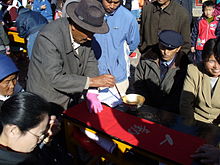Duilian
Duilian ( Chinese 對聯 / 对联 , Pinyin Duìlián ) and Yinglian ( 楹聯 / 楹联 , Yínglián ) are an art form of the Chinese language consisting of a pair of sayings . They are an important part of Chinese culture and especially literature with more than 1000 years of history. They are also used today mainly for the Chinese New Year celebrations .
Appearance

Duìlián can often be found at doorways, which are often written in Chinese calligraphy with black ink on red strips of paper.
The color can vary in each case and, according to tradition, indicates a death in the family. The color red is only used again in the third year.
construction
They are divided into an upper ( 上 聯 / 上 联 , shànglián ) and lower ( 下聯 / 下联 , xiàlián ) part, each of which corresponds to one another according to certain rules. The number of characters in a Duìlián can vary from 4 to 400 and more.
shape
Certain formal rules apply to a Duìlián, the art of which is adherence to and perfecting by the scribe. These formal rules say u. a .:
- the number of characters in the two parts is the same,
- two opposite characters from the two halves are related to each other,
- the meaning of these corresponding characters are similar or belong to the same level of meaning, so in a numerical word there is also a numerical word opposite,
- the part of speech is mostly the same, there is a noun in the lower part , even if a noun is in the same place in the upper part and
- In some pairs of verses, the tones of the syllables of corresponding signs are also coordinated with one another.
example
Example of a Duìlián (in traditional characters )
-
書 山 有 路 勤 爲 徑
- shūshān yǒu lù qín wéi jìng
- "In the mountain of books there is a way and diligence is the path"
-
學海無涯 苦 作 舟
- xuéhǎi wú yá kǔ zuò zhōu
- "The sea of learning is limitless and effort is a boat on it"
| Lower part | Tone pattern | translation | upper part | Tone pattern | translation |
|---|---|---|---|---|---|
| 學 | 仄 | Learning, science | 書 | 平 | book |
| 海 | 仄 | sea | 山 | 平 | mountain |
| 無 | 平 | lack, lack | 有 | 仄 | to have |
| 涯 | 平 | Limit, horizon | 路 | 仄 | path |
| 苦 | 仄 | bitter, laborious | 勤 | 平 | diligent |
| 作 | 仄 | do, do | 爲 | 平 | act, mean |
| 舟 | 平 | boat | 徑 | 仄 | path |
Culture
Writing a Duìlián, similar to writing a poem, provides information about the skill of the writer. This art is also demonstrated in competitions in which a scribe writes the first half of the pair, which then has to be completed by a second scribe.
There are different, special forms.
Chūnlián
During the preparations for the Chinese New Year ("Spring Festival"), a Chūnlián ( 春聯 / 春联 ) is written on ribbons and attached to the left and right at the entrances of the house. Many Chinese companies now adopt this traditional custom and hand out pairs of slogans as business gifts.
Other forms
Other forms are:
- Yínglián ( 楹聯 / 楹联 ) for temples and other classical buildings
- Hèlián ( 賀 聯 / 贺 联 ) at weddings, births, store openings and other festivities
- Wǎnlián ( 輓聯 / 挽联 ) for mourning deaths
- Zènglián ( 贈 聯 / 赠 联 )
- Zhōngtánglián ( 中堂 聯 / 中堂 联 )
See also: double luck
gallery
Red Duìlián (Baishuitai near Shangri-La )
Permanently installed Duìlián with a quote from Mao Zedong 「好好 学习 , 天天 向上」 ( hǎohǎo xuéxí, tiāntiān xiàngshàng ) (Baishuitai)
literature
- Tianchang Lai: Chinese couplets [= Duilian]. Translated and annotated by TC Lai. With an introduction by Ma Meng. Kelly & Walsh et al. a., Hong Kong 1969
- Kewen Chen (Ed.): Gujin duilian [Chinese couplets from ancient and modern times]. Zhongzhou Shuhuashe, Zhengzhou 1983
- Liang Zhangju: Yinglian conghua quanbian / Liang Zhangju deng bianzhu; Bai Huawen, Li Dingxia dianjiao . Beijing chubanshe: Xinhua shudian Beijing fa xing suo jing xiao, Beijing 1996, ISBN 7-200-02831-2 [Contains, among other things, the Yínglián cónghuà 楹联 丛 话 by Liang Zhangju 梁 章 钜 (1775–1849).]



